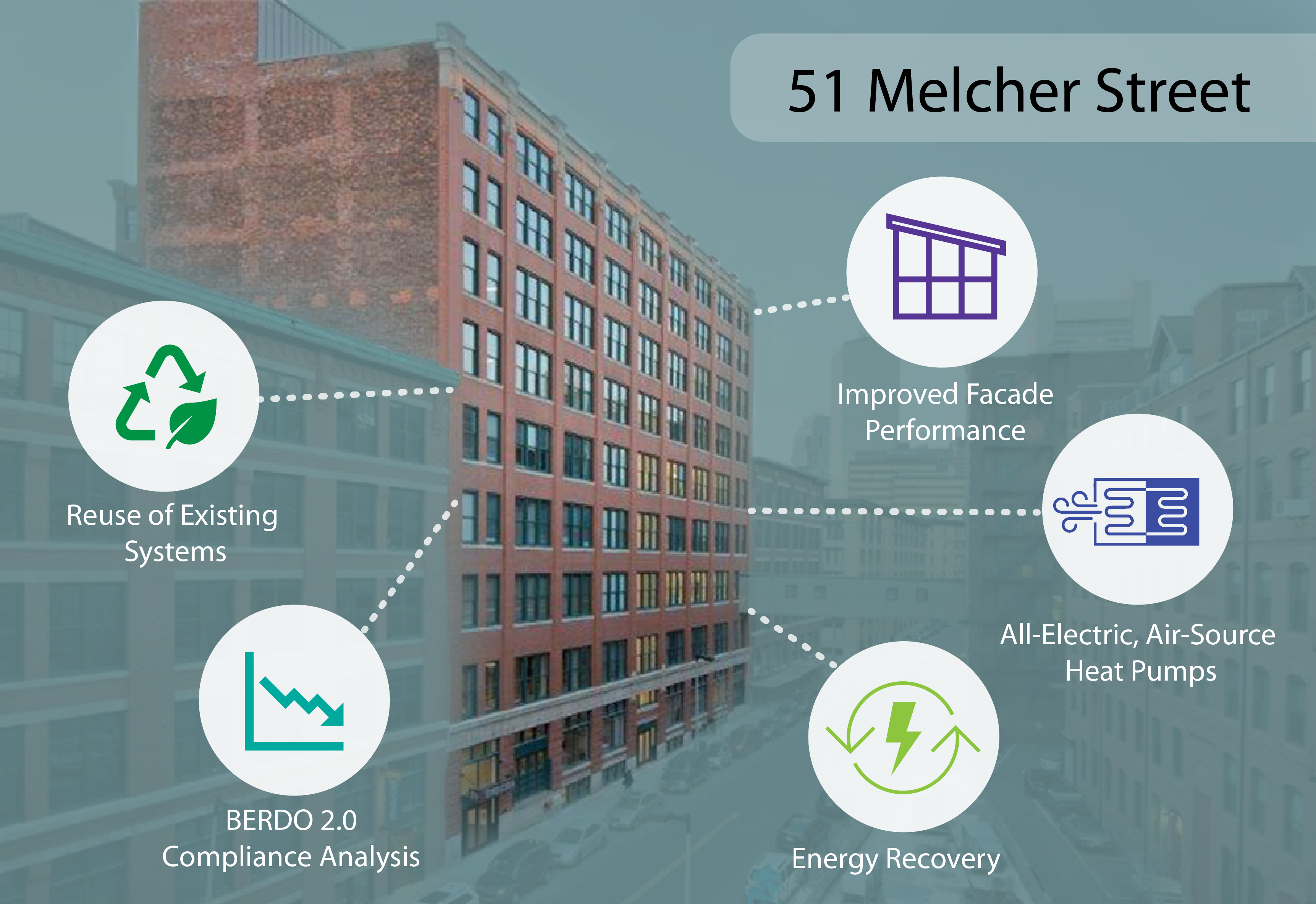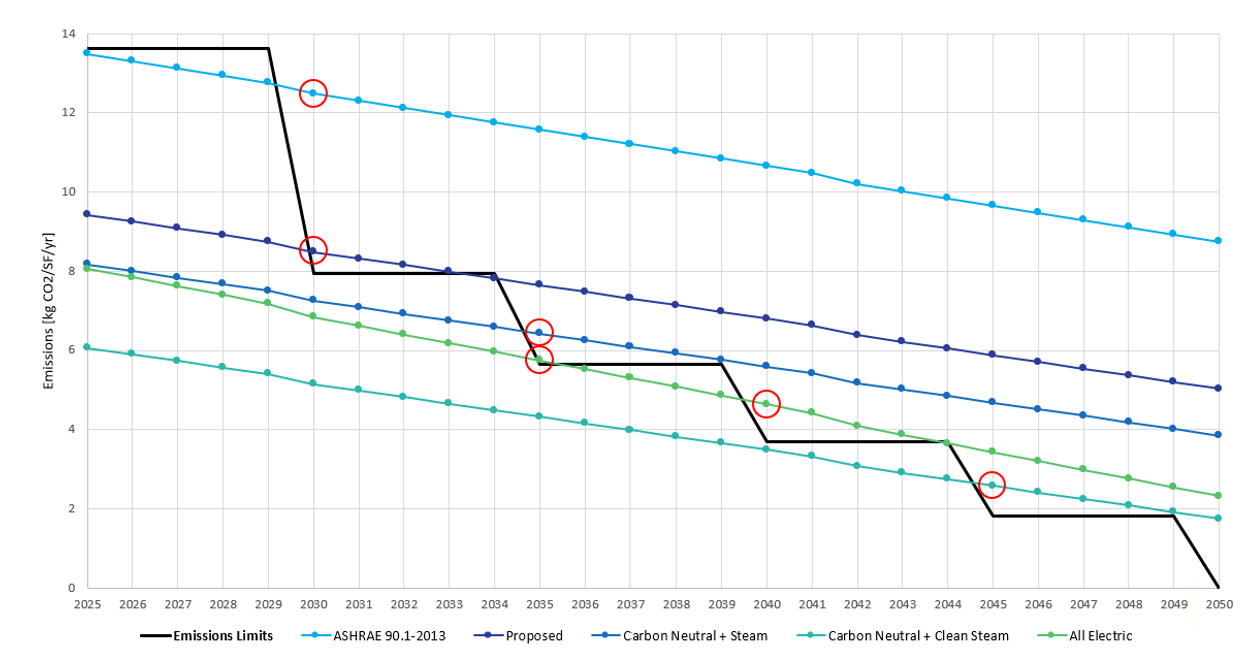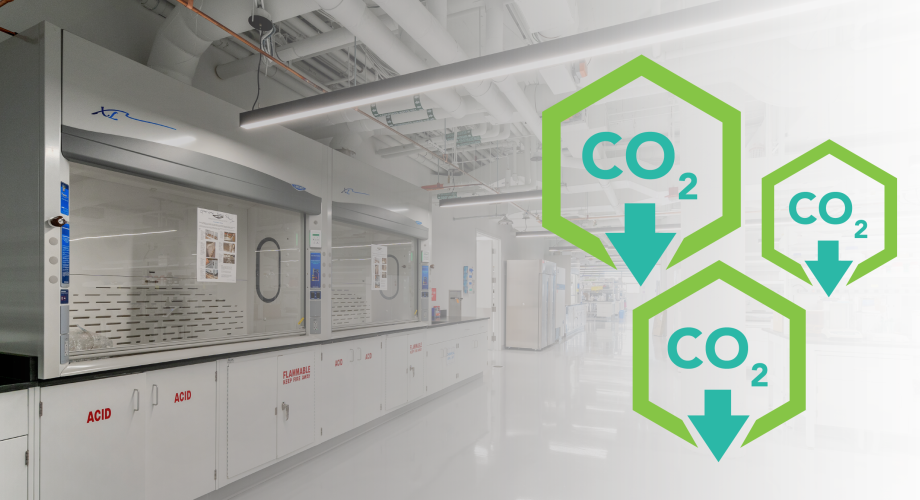Energy intense labs present owners, developers, and designers alike with a unique challenge to balance functional lab design with new emission reduction requirements and energy codes. Decarbonization of the building sector is being accelerated in New England by Boston’s BERDO 2.0 and new DOER Massachusetts Energy Codes which pose stringent building emissions limits and highly efficient energy standards. Now more than ever, converting offices to lab spaces, requires new, more innovative, and future-focused design strategies. A creative and collaborative team is also imperative to meet unique lab needs during our industry’s ever-changing regulatory and construction cost environment.
Office to Lab Considerations and Challenges
While newly constructed lab projects allow for more flexibility in design options, office-to-lab conversion projects are often subject to more constraints and challenges, including structural capability, utility viability, space allocation, and equipment sizing.
Reducing operational carbon emissions in tandem with the conversion of an existing building into a lab requires a highly technical analysis as well as an understanding of laboratory and energy-efficient system options. Engineering-related items that need to be considered include ventilation/conditioning requirements, power loads (normal, standby & life safety), exterior wall thermal performance, structural considerations, and spacing considerations.
Bala understands the challenges of office-to-lab conversions and has resolved a variety of them on a recent office-to-lab conversion at 51 Melcher in Boston, where we are integrating strategies to decarbonize this laboratory design.
51 Melcher Street Decarbonization Strategies and Solutions
51 Melcher is an office-to-lab conversion project located in Boston’s Fort Point District. The existing building totals 9-stories and approximately 100,000 SF, with approximately 60% being converted to lab space and 40% staying as office space.

To meet future BERDO 2.0 emissions standards and requirements from Boston’s Planning and Development Authority (BPDA), Bala’s engineering design utilized system reuse where possible and highly efficient all-electric systems. While working with the owner, architect, and CM, Bala came up with a flexible approach to support future lab requirements and meet emissions/energy targets while also reducing the need for seismic upgrades.
Efficient Design Solutions
In the early phases of design, a series of energy models were performed to analyze the existing façade. Improvements to the exterior wall thermal performance were identified, yielding a significant reduction in energy consumption. A more efficient, and tighter façade resulted in reduced heating and cooling loads.
Integrating energy recovery from laboratory exhaust air systems and fume hoods was another effective project approach. Building heating and cooling systems were downsized due to energy recovery systems’ reducing the peak heating and cooling demands. Bala and the project team engaged in early analysis to confirm viability and coordinate the space planning/configuration impacts of these energy recovery systems.
Reuse and Integration of Existing Infrastructure
Where possible, Bala analyzed existing building infrastructure for potential reuse to support future lab systems. Our team determined that the existing fossil fuel-based heating system was in very good operating condition, and we incorporated this system into initial designs. However, midway through the project design, the BPDA expressed that the project needed to reduce its fossil fuel usage by 90%. To significantly reduce fossil fuel usage, our team then pivoted to use primarily all-electric heating and cooling systems.
This new system approach was very well received by the BPDA and we demonstrated an annual fossil fuel use of only 3% for 51 Melcher – used as a backup in case of extreme temperature swings. The reuse of some existing building infrastructure, including the existing cooling tower and associated condenser water pipework, also decreased the embodied carbon of the project. Reusing existing systems eliminates carbon that would have been produced from manufacturing, transporting, installing, maintaining new systems, and disposing of the old building materials.
All-Electric Design Solutions
Air Source heat pump (ASHP) technology is the prevailing system we are incorporating into the building design for heating and cooling. Our project team’s final design incorporated a combination of air-cooled and water-cooled heat pump equipment for the building’s heating, cooling, and domestic hot water. The ASHPs provide heating/cooling for the main AHUs. This design choice most effectively met the project’s emissions goals and requirements.
BERDO 2.0 Analysis
To ensure future readiness for 51 Melcher, Bala conducted an analysis to compare four design scenarios against long-term BERDO 2.0 emissions limits.
We provided an analysis for the following design options:
- The ASHRAE 90.1-2013 baseline HVAC system
- The original proposed design: reuse of existing fossil fuel system
- A carbon-neutral design with the use of district steam.
- This has been split into two emissions projections as district steam can have an environmental impact if not produced from “clean” renewable energy sources.
- An all-electric design

The first year of non-compliance with the BERDO 2.0 emissions limits has been circled for each of the design scenarios. The slope of these lines is dependent upon the grid decarbonizing over time and the proportion of electricity use versus natural gas or steam use.
- Both the ASHRAE 90.1-2013 baseline and the preliminary proposed design were found to be over the BERDO emissions limits starting in 2030.
- The Carbon Neutral option assuming an unclean production of steam will result in BERDO fines starting in 2035.
- The All-Electric design also shows BERDO 2.0 compliance until 2035, but a longer compliance time period could be extended through efficient energy use. Our analysis identified 2040 as a good time for upgrades that improve energy efficiency to stay in compliance with BERDO 2.0.
- Finally, the Carbon Neutral with clean steam is the last to rise above emissions limits and does so in the year 2045.
Our analysis does not consider future potential upgrades, nor does it consider potentially more drastic grid decarbonization. It’s important to note that both of these factors will affect future compliance with the BERDO emissions limits.
Project Insights and Future Opportunities
To make decarbonization and financial goals a reality, design teams should approach lab projects strategically. For office-to-laboratory conversion projects, we first need to understand the most feasible and adaptable designs for existing buildings. As seen with our 51 Melcher project, optimal strategies come from analyzing existing infrastructure and determining which systems can be reused and what needs to be supplemented to meet program requirements. It’s also important to understand how these adapted and supplemented systems can work together both spatially and architecturally.
Another emerging building decarbonization strategy is “Green Steam” for heating & hot water. Our 51 Melcher project team evaluated Green Steam options during the design process. At this time, further information is required from local Green Steam providers to confirm its generation meets carbon emissions requirements. However, Green Steam could be an option for future projects after careful evaluation with manufacturers.
Developing a Future-focused and Adaptive Approach
Change is constant and the ability to adapt to respond to local guidelines and development authorities is critical. Bala is continuing to invest in internal research and development to identify forward-thinking, sustainable solutions. With holistic evaluation and planning among architects, owners, CMs, design professionals, and manufacturers, decarbonized laboratory design that delivers on sustainability, cost-effectiveness, flexibility, scalability, and overall value is possible.

